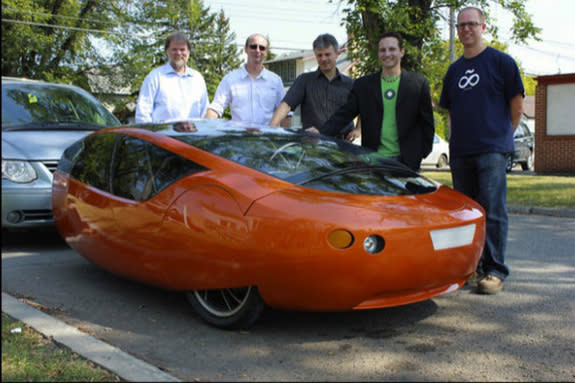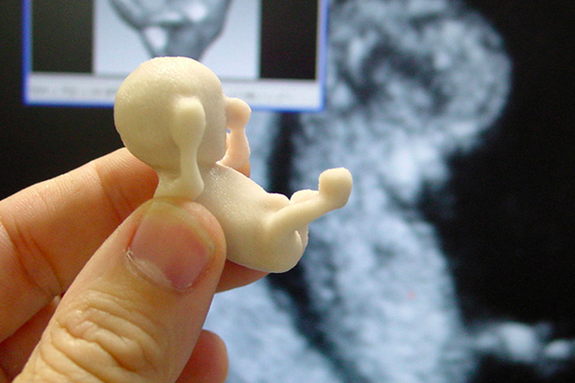15 Surprising Things That Can Be 3D Printed
You might have heard that you can 3D print your own gun, but did you know that 3D printers can also churn out less-destructive objects, like a human liver or a prosthetic hand?
From dinosaur skeletons and plastic fetuses to sporting equipment and bikinis, 3D printing brings the miraculous, the useful and the flat-out bizarre to life.
Human body parts
You might not be able to sign up for a 3D-printed liver just yet, but scientists are already taking steps to make it possible in the near future.
Organovo, a San Diego-based startup specializing in the development of 3D-printed biological materials, prints functioning human liver tissue, and the company believes that it will one day be able to use this tissue to create an entire working organ.
And internal organs aren't the only body parts getting a boost from 3D-printing technology. Researchers at Cornell University recently used a 3D printer to create a human ear that could one day be implanted in a human being.
Prosthetics for people and pets
Who said prosthetics can't be pretty? Bespoke Innovations, a San Francisco-based company founded in 2009 by an orthopedic surgeon and an industrial designer, uses 3D printing to make custom-designed "fairings," or fashionable fitted covers for prosthetic legs.
Whether it's a tattoo graphic or chrome plating, Bespoke fairings add some flair to the otherwise monochrome world of prosthetic limbs.
And then there's Robohand, an Indiegogo-funded, open-source project developed by a South African man who lost four fingers in a woodworking accident and a mechanical-prop designer from Seattle.
Robohand is a 3D-printed prosthetic hand, a first-of-its-kind innovation that lets those without fingers grasp objects.
There are even 3D-printed prosthetics for pets. Take Buttercup, a duck born with a backward foot. Thanks to 3D-printing company NovaCopy, Buttercup now has two fully functioning feet and the chance to lead a normal, web-footed life.
[10 Cool 3D Printing Startups]
Dinosaurs and giant fish
Creating a 3D-printed foot is possible, but what about an entire 3D-printed dinosaur skeleton? Scientists at Drexel University in Philadelphia have developed a way to 3D print scaled-down prehistoric skeletons based on scans of real dinosaur bones.
Paleontologists hold together the miniaturized skeletons with artificial muscles and tendons, creating movable dinosaur robots. The scientists use these "robosaurs" to study the ways dinosaurs moved — research that would have been impossible using the life-size bones of an 80-ton dinosaur.
Marine biologists are also using 3D printing to study deepwater fishes, elusive animals that are difficult to observe in a lab. Replicas of dragonfish — a mysterious, deep-sea predator — can be 3D printed and studied in a lab without the need for high-pressure tanks or utter darkness.
Dead people
If you're going to 3D print extinct animals, you might as well print out a few dead people too, right?
That's what scientists at Loughborough University in the U.K. are doing. They've printed a full 3D replica of a man who has been dead since 1485: King Richard III.
And the British royal isn't the only one to be resurrected by 3D printing. Materialise, a 3D-manufacturing firm headquartered in Belgium, has created a full-scale 3D clone of King Tut, the young pharaoh who's been mummified since 1323 B.C.
[Crazy Companies: Bizarre, But Successful Businesses]
Meat and leather
If bones aren't really your thing, you might be interested to learn that 3D printers also may be able to whip out your next steak dinner.
Modern Meadow, a startup based in Columbia, Mo., is perfecting its methods for 3D printing edible meat products, as well as consumer-grade leather.
Using 3D bioprinting technology, the company aims to reduce the environmental costs associated with the raising, slaughtering and transporting of animals.
Snacks and fast food
Not a meat eater? Don't worry; there's a 3D-printed meal on the horizon for you, too. Researchers at NASA and Cornell University (among other institutions) are currently perfecting the art of 3D printing all kinds of food.
Sea scallops, cookies and banana-flavored gelatin are among the foods that have been successfully printed.
And then there's Marko Manriquez, a New York University graduate student who recently developed a 3D printer, dubbed the Burritobot, that assembles made-to-order burritos via a custom iPhone app.
Drug paraphernalia
Not in the mood for a 3D-printed burrito? Perhaps you would be if you had a 3D-printed bong. Thingiverse, MakerBot's digital community for sharing 3D designs, currently features dozens of files for DIY bongs, bubblers, hand grinders and dugouts —all standard tools of the smoker's trade.
And 3D-printed bongs aren't exclusively available for members of the maker community. Smokers can also buy a 3D-printed bong and other paraphernalia on Shapeways, a virtual 3D marketplace.
Sex toys
In case bongs aren't scandalous enough for you, here's a 3D-printed creation that will really get your blood flowing: the sex toy.
MakerLove, a website where 3D-printer owners can download their preferred erotic toy designs, is just one of many sites that demonstrate the free spirit of the 3D-printing industry.
Cars
A more traditional application for 3D printing is in automobile manufacturing. Many car and motorcycle makers use 3D printing — also called additive or digital manufacturing — to produce some of the finished parts they use in their cars.
And now 3D printers are being used to create an entire vehicle, the URBEE by Kor Ecologic. This futuristic-looking electric car was designed to use as little energy as possible and is capable of reaching more than 200 miles per gallon on the highway. The entire interior and exterior of the URBEE is 3D printed.
Drones
3D printing is taking to the skies as well. The University of Southampton in the U.K. is home to the first 3D-printed unmanned aerial vehicle (UAV), or drone.
The Southampton University Laser Sintered Aircraft (SULSA) can be assembled in 10 minutes once it's printed and doesn't require the use of any screws or traditional fasteners.
SULSA can fly on autopilot or via remote control for around 30 minutes and can reach speeds of 90 mph.
Houses
You might not have any need for a drone, but what about a 3D-printed house? Behrokh Khoshnevis, a professor at the University of Southern California, is currently working with NASA to design 3D-printed structures suitable for living on the moon, but his research also includes 3D-printed homes here on Earth.
In a recent TED talk, Khoshnevis explained the process of using a giant 3D printer, or a "contour crafting" machine that extrudes a concrete mixture to build a house layer by layer. Researchers believe this type of construction would be cheap and endlessly customizable.
Researchers at MIT also recently developed a superstrong 3D-printed material that replicates the fracture resistance of human bone and could one day be used to frame entire buildings.
Wearable tech
One of the most widespread applications of additive manufacturing thus far has been in the fashion industry. Purses, cellphone cases and jewelry are all being 3D printed. But there are still a few wearable 3D-printed items that novelty seekers will love.
N12's 3D-printed bikini is composed of nylon disks held together in a pattern resembling futuristic chainmail. The bikini, which is sold in parts, is available on Shapeways.
And what better accompanies a 3D-printed bikini than a 3D-printed pair of sunglasses? Make Eyewear sells some funky-looking frames that are printed to order.
For shoe lovers, there are plenty of 3D-printed options, including these beauties from Freedom of Creation designer Janne Kyttanen.
Human masks
A 3D printer can spit out more than just your outfit: With a little help from DNA sequencing, one Brooklyn, N.Y.-based artist is using a 3D printer to create eerily lifelike sculptures of human faces.
Heather Dewey-Hagborg, a Ph.D. student at Rensselaer Polytechnic Institute in Troy, N.Y., collects pieces of garbage like cigarette butts and chewing gum. She then extracts DNA samples from these bits of trash, sends the samples to be sequenced in a lab and enters the information she receives into a computer program that creates a 3D image of the anonymous DNA donor's face.
Dewey-Hagborg hits print, and voilà: 3D-printed human masks.
An replica fetus
You might not want to 3D print a stranger's face, but what about the face of your unborn child?
Tecnologia Humana 3D, a Brazilian orthotics company, uses 3D technology to print tiny plastic replicas of fetuses still in utero.
Japanese company Fasotec offers a similar product for expecting parents. Fasotec's 3D fetuses sell for over $1,000 and are meant to be used as desk ornaments.
Surfboards
One of the most widely acclaimed benefits of 3D-printing technology is its ability to execute custom-built designs more affordably than ever. Athletes could be the group that benefits the most from this highly tailored approach to manufacturing.
MADE, a Chicago-based startup, 3D prints "smart" windsurf, kite, surf and paddle boards. The boards are printed to the exact specifications of the user, with the help of microchips embedded in the user's ordinary surfboard.
These microchips collect information about how a person surfs and sends it to a corresponding smartphone app. The app aggregates this data, ultimately allowing a surfer to custom design a board based on his or her preferences and surfing behaviors —pretty gnarly stuff, dude.
Follow Elizabeth Palermo on Twitter @techEpalermo or Google+. Follow BusinessNewsDaily @BNDarticles. We're also on Facebook & Google+.
Copyright 2013 LiveScience, a TechMediaNetwork company. All rights reserved. This material may not be published, broadcast, rewritten or redistributed.




